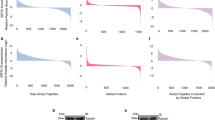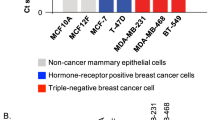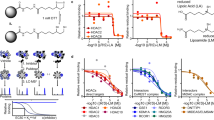Abstract
Lysine deacetylases inhibitors (KDACIs) are used in basic research, and many are being investigated in clinical trials for treatment of cancer and other diseases. However, their specificities in cells are incompletely characterized. Here we used quantitative mass spectrometry (MS) to obtain acetylation signatures for 19 different KDACIs, covering all 18 human lysine deacetylases. Most KDACIs increased acetylation of a small, specific subset of the acetylome, including sites on histones and other chromatin-associated proteins. Inhibitor treatment combined with genetic deletion showed that the effects of the pan-sirtuin inhibitor nicotinamide are primarily mediated by SIRT1 inhibition. Furthermore, we confirmed that the effects of tubacin and bufexamac on cytoplasmic proteins result from inhibition of HDAC6. Bufexamac also triggered an HDAC6-independent, hypoxia-like response by stabilizing HIF1-α, providing a possible mechanistic explanation of its adverse, pro-inflammatory effects. Our results offer a systems view of KDACI specificities, providing a framework for studying function of acetylation and deacetylases.
This is a preview of subscription content, access via your institution
Access options
Subscribe to this journal
Receive 12 print issues and online access
$209.00 per year
only $17.42 per issue
Buy this article
- Purchase on Springer Link
- Instant access to full article PDF
Prices may be subject to local taxes which are calculated during checkout





Similar content being viewed by others
References
Grunstein, M. Histone acetylation in chromatin structure and transcription. Nature 389, 349–352 (1997).
Cheung, W.L., Briggs, S.D. & Allis, C.D. Acetylation and chromosomal functions. Curr. Opin. Cell Biol. 12, 326–333 (2000).
Valenzuela-Fernández, A., Cabrero, J.R., Serrador, J.M. & Sanchez-Madrid, F. HDAC6: a key regulator of cytoskeleton, cell migration and cell-cell interactions. Trends Cell Biol. 18, 291–297 (2008).
Yang, X.J. & Seto, E. Lysine acetylation: codified crosstalk with other posttranslational modifications. Mol. Cell 31, 449–461 (2008).
Haberland, M., Montgomery, R.L. & Olson, E.N. The many roles of histone deacetylases in development and physiology: implications for disease and therapy. Nat. Rev. Genet. 10, 32–42 (2009).
Finkel, T., Deng, C.X. & Mostoslavsky, R. Recent progress in the biology and physiology of sirtuins. Nature 460, 587–591 (2009).
Montgomery, R.L., Hsieh, J., Barbosa, A.C., Richardson, J.A. & Olson, E.N. Histone deacetylases 1 and 2 control the progression of neural precursors to neurons during brain development. Proc. Natl. Acad. Sci. USA 106, 7876–7881 (2009).
Bolden, J.E., Peart, M.J. & Johnstone, R.W. Anticancer activities of histone deacetylase inhibitors. Nat. Rev. Drug Discov. 5, 769–784 (2006).
Marks, P.A. The clinical development of histone deacetylase inhibitors as targeted anticancer drugs. Expert Opin. Investig. Drugs 19, 1049–1066 (2010).
Archin, N.M. et al. Administration of vorinostat disrupts HIV-1 latency in patients on antiretroviral therapy. Nature 487, 482–485 (2012).
Grabiec, A.M., Tak, P.P. & Reedquist, K.A. Function of histone deacetylase inhibitors in inflammation. Crit. Rev. Immunol. 31, 233–263 (2011).
Kazantsev, A.G. & Thompson, L.M. Therapeutic application of histone deacetylase inhibitors for central nervous system disorders. Nat. Rev. Drug Discov. 7, 854–868 (2008).
Iyer, A., Fairlie, D.P. & Brown, L. Lysine acetylation in obesity, diabetes and metabolic disease. Immunol. Cell Biol. 90, 39–46 (2012).
Khan, O. & La Thangue, N.B. HDAC inhibitors in cancer biology: emerging mechanisms and clinical applications. Immunol. Cell Biol. 90, 85–94 (2012).
Xu, W.S., Parmigiani, R.B. & Marks, P.A. Histone deacetylase inhibitors: molecular mechanisms of action. Oncogene 26, 5541–5552 (2007).
Tan, J., Cang, S., Ma, Y., Petrillo, R.L. & Liu, D. Novel histone deacetylase inhibitors in clinical trials as anti-cancer agents. J. Hematol. Oncol. 3, 5 (2010).
Dell′Aversana, C., Lepore, I. & Altucci, L. HDAC modulation and cell death in the clinic. Exp. Cell Res. 318, 1229–1244 (2012).
Bradner, J.E. et al. Chemical phylogenetics of histone deacetylases. Nat. Chem. Biol. 6, 238–243 (2010).
Bantscheff, M. et al. Chemoproteomics profiling of HDAC inhibitors reveals selective targeting of HDAC complexes. Nat. Biotechnol. 29, 255–265 (2011).
Salisbury, C.M. & Cravatt, B.F. Activity-based probes for proteomic profiling of histone deacetylase complexes. Proc. Natl. Acad. Sci. USA 104, 1171–1176 (2007).
Ong, S.E. et al. Stable isotope labeling by amino acids in cell culture, SILAC, as a simple and accurate approach to expression proteomics. Mol. Cell. Proteomics 1, 376–386 (2002).
Choudhary, C. et al. Lysine acetylation targets protein complexes and co-regulates major cellular functions. Science 325, 834–840 (2009).
Weinert, B.T. et al. Lysine succinylation is a frequently occurring modification in prokaryotes and eukaryotes and extensively overlaps with acetylation. Cell Reports 4, 842–851 (2013).
Sterner, D.E. & Berger, S.L. Acetylation of histones and transcription-related factors. Microbiol. Mol. Biol. Rev. 64, 435–459 (2000).
Drogaris, P. et al. Histone deacetylase inhibitors globally enhance h3/h4 tail acetylation without affecting h3 lysine 56 acetylation. Sci. Rep. 2, 220 (2012).
Buggy, J.J. et al. CRA-024781: a novel synthetic inhibitor of histone deacetylase enzymes with antitumor activity in vitro and in vivo. Mol. Cancer Ther. 5, 1309–1317 (2006).
Haggarty, S.J., Koeller, K.M., Wong, J.C., Grozinger, C.M. & Schreiber, S.L. Domain-selective small-molecule inhibitor of histone deacetylase 6 (HDAC6)-mediated tubulin deacetylation. Proc. Natl. Acad. Sci. USA 100, 4389–4394 (2003).
Balasubramanian, S. et al. A novel histone deacetylase 8 (HDAC8)-specific inhibitor PCI-34051 induces apoptosis in T-cell lymphomas. Leukemia 22, 1026–1034 (2008).
Ben-Shahar, T.R. et al. Eco1-dependent cohesin acetylation during establishment of sister chromatid cohesion. Science 321, 563–566 (2008).
Unal, E. et al. A molecular determinant for the establishment of sister chromatid cohesion. Science 321, 566–569 (2008).
Zhang, J. et al. Acetylation of Smc3 by Eco1 is required for S phase sister chromatid cohesion in both human and yeast. Mol. Cell 31, 143–151 (2008).
Deardorff, M.A. et al. HDAC8 mutations in Cornelia de Lange syndrome affect the cohesin acetylation cycle. Nature 489, 313–317 (2012).
Bitterman, K.J., Anderson, R.M., Cohen, H.Y., Latorre-Esteves, M. & Sinclair, D.A. Inhibition of silencing and accelerated aging by nicotinamide, a putative negative regulator of yeast sir2 and human SIRT1. J. Biol. Chem. 277, 45099–45107 (2002).
Chen, Y. et al. Quantitative acetylome analysis reveals the roles of SIRT1 in regulating diverse substrates and cellular pathways. Mol. Cell. Proteomics 11, 1048–1062 (2012).
Kim, S.C. et al. Substrate and functional diversity of lysine acetylation revealed by a proteomics survey. Mol. Cell 23, 607–618 (2006).
Zhao, S. et al. Regulation of cellular metabolism by protein lysine acetylation. Science 327, 1000–1004 (2010).
Zhang, X. et al. HDAC6 modulates cell motility by altering the acetylation level of cortactin. Mol. Cell 27, 197–213 (2007).
Uter, W. & Schnuch, A. EMA revokes marketing authorization for bufexamac. Contact Derm. 64, 235–236 (2011).
Fukuda, H., Sato, Y., Usami, N., Yokouchi, Y. & Mukai, H. Contact dermatitis caused by bufexamac sparing the eruption of herpes zoster. J. Dermatol. 39, 405–407 (2012).
Jeong, J.W. et al. Regulation and destabilization of HIF-1alpha by ARD1-mediated acetylation. Cell 111, 709–720 (2002).
Dokmanovic, M., Clarke, C. & Marks, P.A. Histone deacetylase inhibitors: overview and perspectives. Mol. Cancer Res. 5, 981–989 (2007).
Yang, H. et al. Nutrient-sensitive mitochondrial NAD+ levels dictate cell survival. Cell 130, 1095–1107 (2007).
Lain, S. et al. Discovery, in vivo activity, and mechanism of action of a small-molecule p53 activator. Cancer Cell 13, 454–463 (2008).
Anderson, K.A. & Hirschey, M.D. Mitochondrial protein acetylation regulates metabolism. Essays Biochem. 52, 23–35 (2012).
Hirschey, M.D., Shimazu, T., Huang, J.Y., Schwer, B. & Verdin, E. SIRT3 regulates mitochondrial protein acetylation and intermediary metabolism. Cold Spring Harb. Symp. Quant. Biol. 76, 267–277 (2011).
Wagner, G.R. & Payne, R.M. Mitochondrial acetylation and diseases of aging. J. Aging Res. 2011, 234875 (2011).
He, W., Newman, J.C., Wang, M.Z., Ho, L. & Verdin, E. Mitochondrial sirtuins: regulators of protein acylation and metabolism. Trends Endocrinol. Metab. 23, 467–476 (2012).
Eltzschig, H.K. & Carmeliet, P. Hypoxia and inflammation. N. Engl. J. Med. 364, 656–665 (2011).
Vizcaíno, J.A. et al. ProteomeXchange provides globally coordinated proteomics data submission and dissemination. Nat. Biotechnol. 32, 223–226 (2014).
Nagaraj, N. et al. Deep proteome and transcriptome mapping of a human cancer cell line. Mol. Syst. Biol. 7, 548 (2011).
Zhang, Y. et al. Mice lacking histone deacetylase 6 have hyperacetylated tubulin but are viable and develop normally. Mol. Cell. Biol. 28, 1688–1701 (2008).
McBurney, M.W. et al. The mammalian SIR2alpha protein has a role in embryogenesis and gametogenesis. Mol. Cell. Biol. 23, 38–54 (2003).
Vaquero, A. et al. SirT2 is a histone deacetylase with preference for histone H4 Lys 16 during mitosis. Genes Dev. 20, 1256–1261 (2006).
Mostoslavsky, R. et al. Genomic instability and aging-like phenotype in the absence of mammalian SIRT6. Cell 124, 315–329 (2006).
Rappsilber, J., Mann, M. & Ishihama, Y. Protocol for micro-purification, enrichment, pre-fractionation and storage of peptides for proteomics using StageTips. Nat. Protoc. 2, 1896–1906 (2007).
Michalski, A. et al. Mass spectrometry-based proteomics using Q Exactive, a high-performance benchtop quadrupole Orbitrap mass spectrometer. Mol. Cell. Proteomics 10, M111 011015 (2011).
Kelstrup, C.D., Young, C., Lavallee, R., Nielsen, M.L. & Olsen, J.V. Optimized fast and sensitive acquisition methods for shotgun proteomics on a quadrupole orbitrap mass spectrometer. J. Proteome Res. 11, 3487–3497 (2012).
Waanders, L.F. et al. A novel chromatographic method allows on-line reanalysis of the proteome. Mol. Cell. Proteomics 7, 1452–1459 (2008).
Elias, J.E. & Gygi, S.P. Target-decoy search strategy for increased confidence in large-scale protein identifications by mass spectrometry. Nat. Methods 4, 207–214 (2007).
Emerling, B.M., Weinberg, F., Liu, J.L., Mak, T.W. & Chandel, N.S. PTEN regulates p300-dependent hypoxia-inducible factor 1 transcriptional activity through Forkhead transcription factor 3a (FOXO3a). Proc. Natl. Acad. Sci. USA 105, 2622–2627 (2008).
Weinert, B.T. et al. Real-time PCR analysis of genes encoding tumor antigens in esophageal tumors and a cancer vaccine. Cancer Immun. 9, 9 (2009).
Szklarczyk, D. et al. The STRING database in 2011: functional interaction networks of proteins, globally integrated and scored. Nucleic Acids Res. 39, D561–D568 (2011).
Cline, M.S. et al. Integration of biological networks and gene expression data using Cytoscape. Nat. Protoc. 2, 2366–2382 (2007).
Bindea, G. et al. ClueGO: a Cytoscape plug-in to decipher functionally grouped gene ontology and pathway annotation networks. Bioinformatics 25, 1091–1093 (2009).
Garcia, O. et al. GOlorize: a Cytoscape plug-in for network visualization with Gene Ontology-based layout and coloring. Bioinformatics 23, 394–396 (2007).
Acknowledgements
We thank the members of the department of proteomics at CPR for their helpful discussions. We thank T. Narita for providing help with bioinformatic analyses. We thank R. Lavallee, D. Bekker-Jensen, H.C. Grell and B. Smith for their technical support. We gratefully acknowledge M.W. McBurney for providing SIRT1 knockout MEFs, D. Reinberg for providing SIRT2 knockout MEFs, and R. Mostoslavsky for providing SIRT6 knockout MEFs. This work was supported by the Hallas Møller Investigator grant from the Novo Nordisk Foundation to C.C. S.A.W. and P.B. were supported by individual postdoctoral grants from the Danish Research Council (FSS: 10-085134, FSS: 12-12610). C.C. is supported by the EMBO Young Investigator program. The Center for Protein Research is supported by a generous grant from the Novo Nordisk Foundation (grant no. NNF14CC0001). J.E.B. is supported by a grant from the Doris Duke Charitable Foundation. We thank the PRIDE team for their support with data storage.
Author information
Authors and Affiliations
Contributions
C.S. performed most of the experiments and collected data. B.T.W. performed initial experiments, and obtained data in MV4-11 cells, S.A.W. helped with bioinformatic analyses, P.B. assisted with immunofluorescence microscopy, Y.M. provided HDAC6 knockout cells, L.J.J. performed average linkage clustering analysis of KDACIs, W.S. performed UV/VIS spectroscopy, J.Q. synthesized JQ12 and performed in vitro KDAC enzymatic assays for this compound, A.R.M., N.J.W. and S.L. provided tenovin-6, J.C. helped with computational analysis of MS data, P.M. provided critical research reagents, M.M. was involved in the planning of the tenovin-6 experiments and provided infrastructure for initial test experiments, J.E.B. designed experiments, provided pandacostat and JQ12, C.C. planned the project, C.C. and C.S. wrote the manuscript; all co-authors provided input for writing the paper.
Corresponding author
Ethics declarations
Competing interests
The authors declare no competing financial interests.
Supplementary information
Supplementary Text and Figures
Supplementary Figures 1–14, Supplementary Table 1 and Supplementary Notes 1 and 2 (PDF 3622 kb)
Supplementary Table 2
All identified acetylation sites (XLSX 6912 kb)
Supplementary Table 3
Comparison of short- and long-term Nicotinamide treatment in HeLa cells (XLSX 498 kb)
Supplementary Table 4
Nicotinamide upregulated acetylation sites (XLSX 552 kb)
Supplementary Table 5
List of acetylation sites quantified in MV4-11 cells treated with nicotinamide (XLSX 397 kb)
Supplementary Table 6
Comparison of Nicotinamide treatment and SIRT1KO in MEF Cells (XLSX 658 kb)
Supplementary Table 7
Comparison of Nicotinamide treatment and SIRT6KO in MEF Cells (XLSX 572 kb)
Supplementary Table 8
Comparison of Sirtinol treatment and SIRT2KO in MEF Cells (XLSX 392 kb)
Supplementary Table 9
Comparison of AGK2 treatment and SIRT2KO in MEF Cells (XLSX 440 kb)
Supplementary Table 10
EX-527 treatment in HeLa cells (XLSX 649 kb)
Supplementary Table 11
Overview of bufexamac and tubacin upregulated acetylome (XLSX 116 kb)
Supplementary Table 12
Comparison of Bufexamac and Tubacin treatment and HDAC6KO in MEF Cells (XLSX 609 kb)
Supplementary Table 13
High and low dose bufexamac proteome (XLSX 1794 kb)
Rights and permissions
About this article
Cite this article
Schölz, C., Weinert, B., Wagner, S. et al. Acetylation site specificities of lysine deacetylase inhibitors in human cells. Nat Biotechnol 33, 415–423 (2015). https://doi.org/10.1038/nbt.3130
Received:
Accepted:
Published:
Issue Date:
DOI: https://doi.org/10.1038/nbt.3130
This article is cited by
-
Chemoproteomic target deconvolution reveals Histone Deacetylases as targets of (R)-lipoic acid
Nature Communications (2023)
-
Collateral lethality between HDAC1 and HDAC2 exploits cancer-specific NuRD complex vulnerabilities
Nature Structural & Molecular Biology (2023)
-
Acetylation of histone H2B marks active enhancers and predicts CBP/p300 target genes
Nature Genetics (2023)
-
Linking post-translational modifications and protein turnover by site-resolved protein turnover profiling
Nature Communications (2022)
-
Structure-based prediction of HDAC6 substrates validated by enzymatic assay reveals determinants of promiscuity and detects new potential substrates
Scientific Reports (2022)



